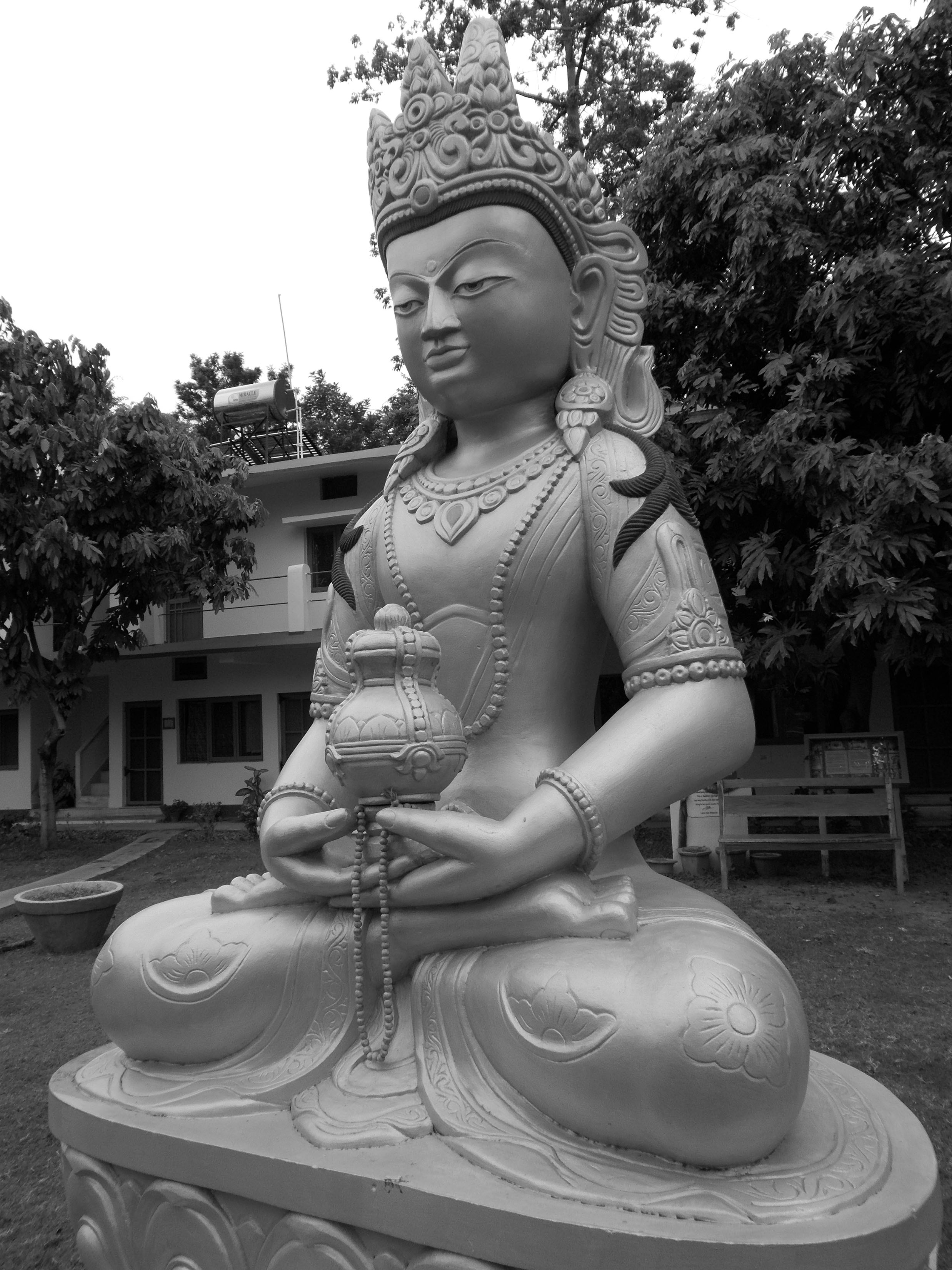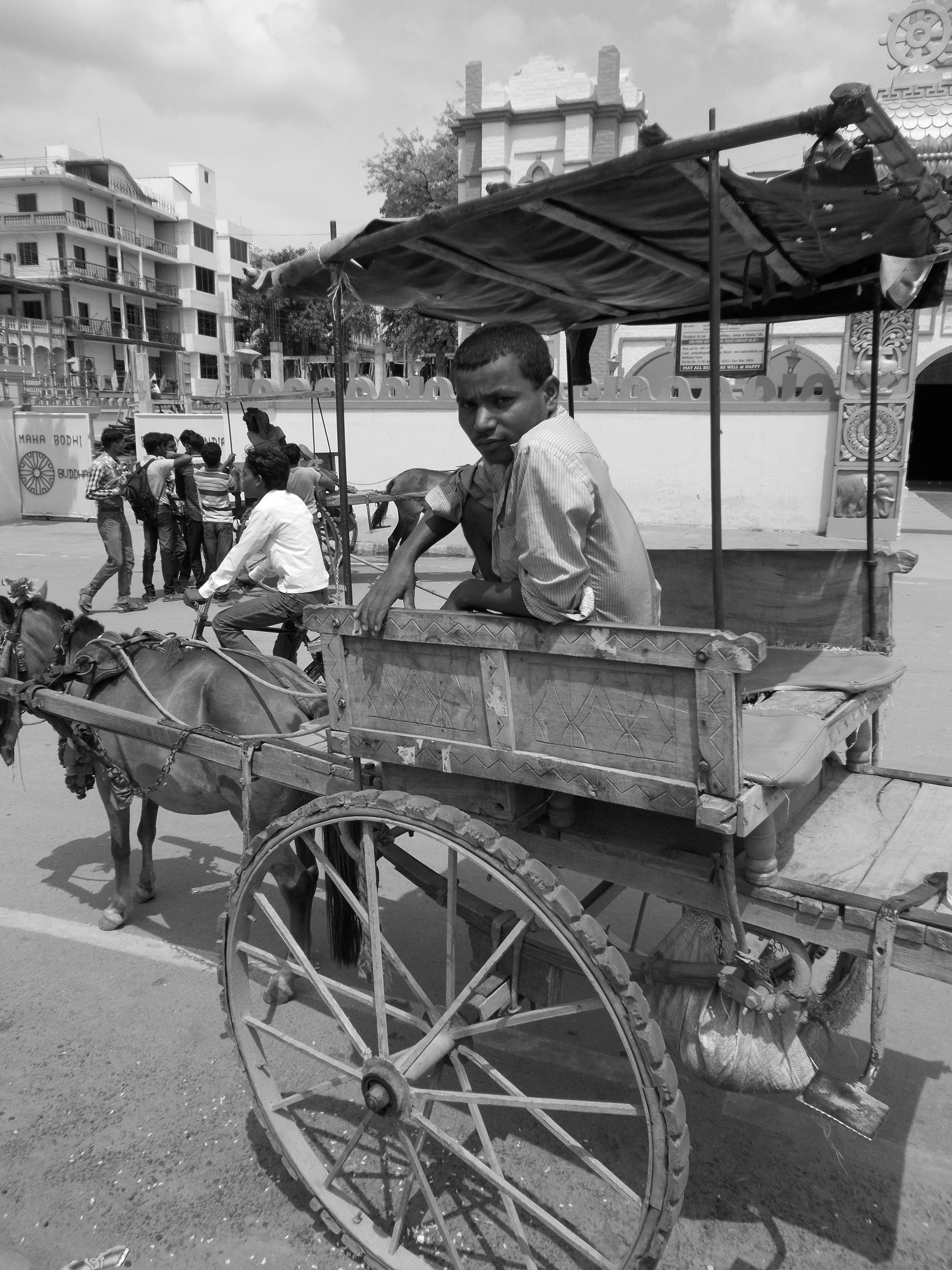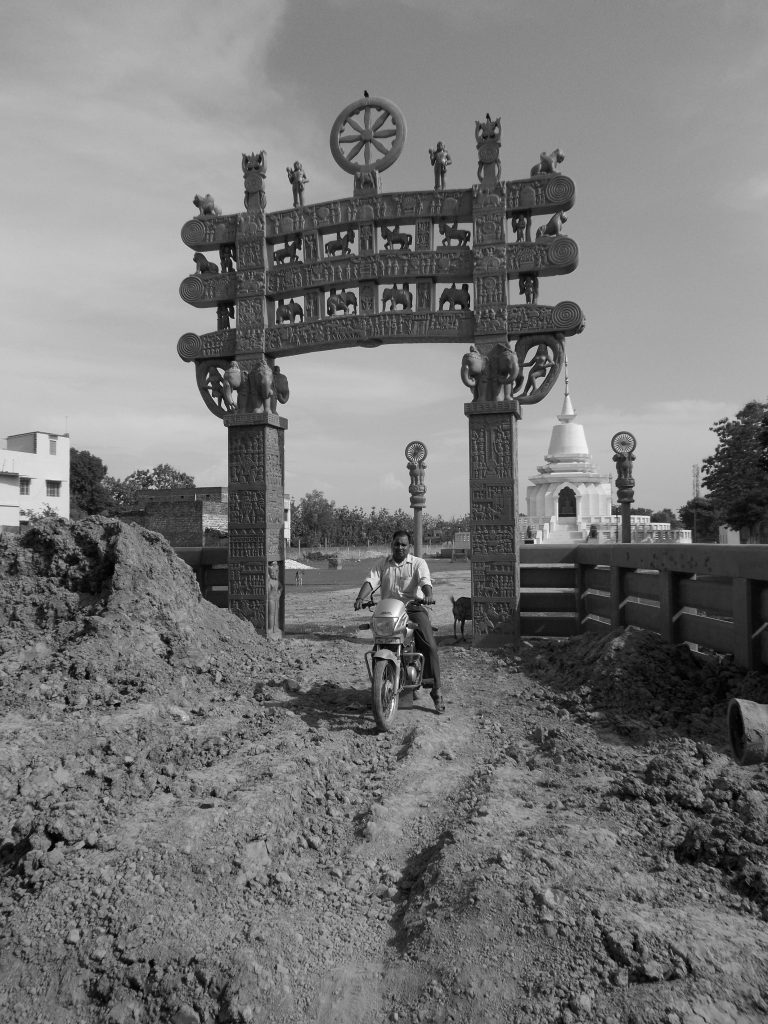Bodh Gaya, it is said, is the number one place to go to realize that you don’t need to go to Bodh Gaya. The small town in India is famous for one reason: here, the Buddha achieved spiritual enlightenment under a ficus tree some twenty-five centuries ago. Some regard the place as a spiritual mecca.
But Buddhists have no mecca, strictly speaking. There are four Buddhist holy sites in the Indian subcontinent—Lumbini, Bodh Gaya, Sarnath, and Kushinagar—where the Buddha was born, was enlightened, first preached, and died, respectively—but visiting any of them is non-obligatory for even the most devout people. Despite the long tradition of pilgrims journeying to these holy sites, there is nothing in the teachings mandating that Buddhists visit.
But a trip to spiritual India can do a person a world of good, it turns out. With their proliferation of golden temples, these holy sites offer the strongest concentration of Buddhism in the world. When one needs a particularly heavy dose of refuge-taking, there may be no better place. This is especially true if you are visiting from Bangladesh, across the eastern border of India, like I was.
Bangladesh’s capital, Dhaka, is a tough knot of metropolis in a somewhat softer country, like New York in America. But the city is New York Extra: a town built for three million where fifteen million people reside, a mob scene in which filth, corruption, poverty, traffic, and noise are rampant and relentless. In 2012, The Economist ranked it the least livable city in the world.
I moved there in 2012, just after that listing came out. I soon realized that my life as a mental health researcher in Dhaka involved a tension so exaggerated that it was worthy of The Onion. “8.4 Million New Yorkers Suddenly Realize New York City A Horrible Place To Live,” reads one of the satirical paper’s headlines. In Dhaka, I lived out the article’s jibes. I yelled at people for walking too slowly. A blaring car horn once threw my roommate, an American schoolteacher, into a rage. Our lives were a joke with no one left to laugh.
In the evenings I watched the sun set over the city from our building’s concrete roof. There I tried to unwind my my tension by chanting the Sino-Korean refuge-taking vows I had learned in a Buddhist temple back in America.
Recognizing that Dhaka far outdid The Onion’s comparatively gentle mockery, I also began to plan a very necessary trip across the border. I was exhausted. I needed refuge from a city where everyone’s empathy, including my own, seemed dead or dying.
And instead of archaic chanting, I began to sing a song that expressed what it felt like to be here—one I would keep singing until I saw spiritual India. Each night in Dhaka, hidden away on the roof, I sang “I And Love And You,” by the Avett Brothers:
Oh, Brooklyn, Brooklyn, take me in.
Are you aware the shape I’m in?
My hands, they shake. My head, it spins.
Oh, Brooklyn, Brooklyn, take me in.
* * *
Dhaka, Bangladesh, March 2013
It was twilight on a temperate spring day, and on the walk home from work the corner flower-sellers looked especially picturesque. Everything was lovely, except the dying man on the sidewalk.
He lay face down, with his walking stick cast aside and a cluster of small bills falling loosely from his calloused hand. He was a beggar, not only emaciated but also stunted from lifelong hunger. His breathing was an urgent rattle.
I bent down to feel his pulse. I knew this accomplished nothing. But because a foreign woman was observing the man, a crowd gathered. They looked at me, not him. I asked what to do. They shrugged. I suggested the hospital. They gave me funny looks—who would pay for that? “He needs help,” I insisted uselessly. “Give him some money, then,” one said in Bengali. Foreign or not, I genuinely had little to give. My chest ached.
One man started to laugh as we all walked away. I felt startled, then so ashamed.
* * *
Sarnath, India, June 2013
I had come to this small, ancient town, where the Buddha gave his first teaching, on holiday. It was the low season, a time when temperatures climbed to 105ºF and hotel prices dipped to 40 rupees a night.
Under a clear blue sky, I walked down one of the tiny roads in Sarnath, looking for the Japanese temple I knew was in the general area. I stopped to ask a thin man with a bicycle. He surprised me with an enthusiastic response. We struggled for a moment with Hindi, English, and Bengali, and although he understood my question, I found his answer opaque. I smiled. He kept trying.
Finally, a friend of his happened to pass by on a motorcycle. He flagged the man down. “Would you take her to the Japanese temple?” the thin man asked in Hindi. “I would do it, but my bike tire is flat.”
The man on the motorcycle nodded. I bid the thin man with the bicycle Namaste and hopped on the motorcycle behind him, sidesaddle.
We rode down the gravel paths and pitted tracks of the town’s backstreets for perhaps a kilometer, and then emerged into a big field with an enormous white marble altar. The man on the motorcycle paused at an ornate stone gate to let me down. Then he went back the way he’d come. My trip had been exactly opposite the way he’d been headed.
The Japanese temple was next door to the massive altar. The thin man with the bicycle had had no obligation beyond pointing a finger. In Dhaka, even a lift to the emergency room was a dubious request; in Sarnath, hospitality was gracious and over-abundant.
* * *
Dhaka, Bangladesh, April 2013
The sky was bright blue, and the road, for once, was clear of traffic. The taxi blasted down the wide lanes in Sher-e-Bangla Nagar, near Bangladesh’s Parliament building, so fast that the subtropical breeze felt cold. For a moment, I enjoyed the ride.
But then we passed an accident scene. It was small and inconspicuous: a single young man had upended his motorcycle somehow. He was in the lane nearest the sidewalk, lying prone with the bike on top of him. His head must have been injured. His body shook violently in a grand mal seizure. Another young man was straining to push the motorcycle off of him.
I asked my taxi driver to stop. I had no exact plan, but rather a painful feeling of needing to help. “No!” the driver spat over his shoulder. He accelerated down the nearly empty street under the clear blue sky. I was stunned into silence.
* * *
Bodh Gaya, India, June 2013
In the road, I met a former Buddhist monk. It was the low season, and he had time to spare. We talked for a long time, and he offered to take me to an acupuncture clinic for the fatigue and sadness he saw in my eyes. We found the place, but the doctor was not in. The man, Akhtar, had another idea: would I like to visit the banyan tree?
I would. It is one of three sites near Bodh Gaya related to the Buddha’s enlightenment. The first is the cave where he is said to have meditated for six years as an ascetic. The second is the banyan; while meditating here for six weeks, the Buddha is said to have met a woman who offered him food, ending his self-inflicted near-starvation. She made it possible for him to walk to the third site, the Bodhi tree in Bodh Gaya town, where he had meditated for six days and finally attained enlightenment.

We rode through the open countryside on Akhtar’s motorcycle—he apologized each time we hit a bump—and ended up under an enormous ancient tree with visible roots. Under its shade, Akhtar asked what had scared me. The direct question surprised me so much that tears welled in my eyes. Dhaka was very rough, I said. There was so little compassion there, and my desire to help was face-to-face with a rough coldness that I did not really understand.
His own troubles must have been tougher. But Akhtar looked at me with empathy. My sadness lifted.
* * *
Dhaka, Bangladesh, May 2013
On the way to the bus stop, I passed an open pissoir. The smell was so intense that I couldn’t understand how a man lying on a nearby bench could be sleeping.
But it became clear that he was not sleeping, but rather unconscious. The man’s neck was cricked, his mouth open. He breathed in slow, congested gasps that sounded, even from my passing evaluation, like the respiratory depression of a heroin high.
He was on his back with arms flung outward. On each forearm, the spots where he’d shot up were marked by infected, blackened rings. The skin was stretched and cracked by extravasation, a medical problem from poorly-done injections. The man’s legs were covered in track marks, too, and a long line of blood had run down his right shin, puddled on his big toe, and dried into a burgundy crust. His broken sandal hung crookedly from his foot.
As I stood there, I considered what it might feel like to be him—the dimness of an opiate high, the self-hatred or fearful rage it masked—and the degradation of lying in the street, near death, with painful ruined veins. I wanted to call the ambulance service for him, but Dhaka has none.
* * *
Bodh Gaya, India, June 2013
Because it was low season and the guesthouse was so empty, the staff let me join a private teaching of the visiting Tibetan lama. I’d noticed this quiet, friendly monk over dinner. The seven guesthouse volunteers, a friendly dog, and I sat in three rows before him. His translator sat nearby, interpreting his lecture on the Tibetan concept of serving others.
The lesson admonished us to always consider ourselves inferior to everyone else. Referencing ancient verses, the monk said to regard even abusive, mentally unwell people as important spiritual teachers. (The printed English text called such people “rare.”) After the lecture, a white man asked a question that is obvious to Westerners: What about low self-esteem, self-hatred, and people who feel inferior in the worst way?

The translator couldn’t understand. What is low self-esteem? What is self-hatred? Could we please explain? Gradually, all eight Westerners attempted descriptions. The translator made noises of confusion, and then the lama made them, too. The idea of hating yourself—or even disliking yourself—does not make sense in Tibetan culture, they said. There is no such thing.
* * *
In India, I would find myself in a shared taxi with a stranger who asked if I’d been swindled or harmed. “No,” I said, and everyone looked shocked. Dhaka is not so much tougher than Gaya, Bihar, just a few miles from Bodh Gaya’s sumptuous golden temples, where thin children sleep on the pavement at the railway station. Nor had news items about gang rape in India escaped anyone’s notice.
But my luck was the opposite: India was the place I’d been singing about. There the spiritual community had taken me in and granted me help (for no greater reason than the compassion that floats freely in spiritual places) and tried to erase my self-doubt (aware, it seemed, that self-doubt served no purpose in the hard-edged place we all lived). It was easy to love India, and easy to feel wrenching guilt that I hadn’t been more helpful to people in Dhaka who also needed refuge.
When we met, Akhtar had offered to take me to the Buddha’s cave, a few kilometers beyond the banyan tree. Feeling lingering fear, I turned him down. But after he dropped me off, I wondered why I hadn’t gone. Akhtar hadn’t been inappropriate or unkind for a moment. He was more social worker than Lothario. It would have been wiser to spend my time with him, learning to mimic the compassion of a guy who had lived all his life in complex, troubled Bihar state, a place not unlike Dhaka.
Just before I left Bodh Gaya, I chanced upon Akhtar again in the road. I told him that in autumn my work contract would end in Dhaka. “Expect me then,” I said.
He smiled, and as we parted ways, I began to sing a new, old song: the ancient refuge-taking chants I had once forgotten on a roof in Dhaka.
Thank you for subscribing to Tricycle! As a nonprofit, we depend on readers like you to keep Buddhist teachings and practices widely available.
